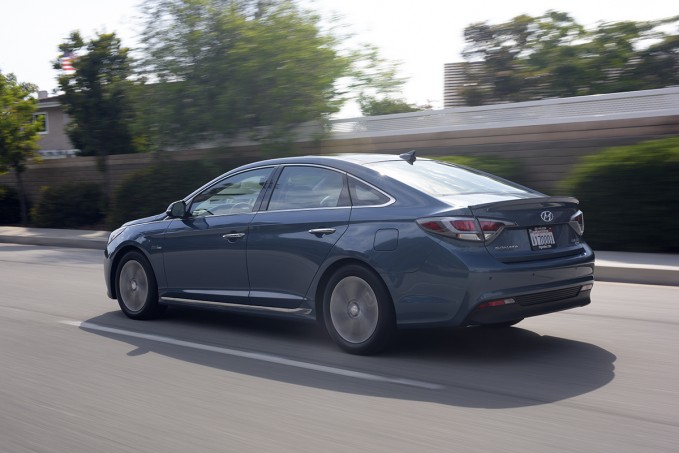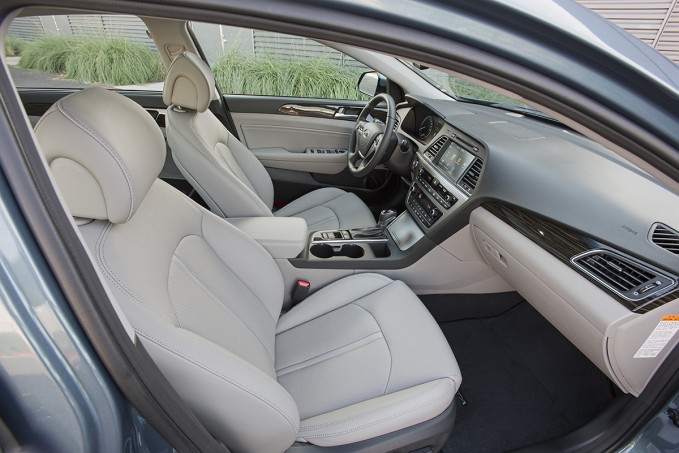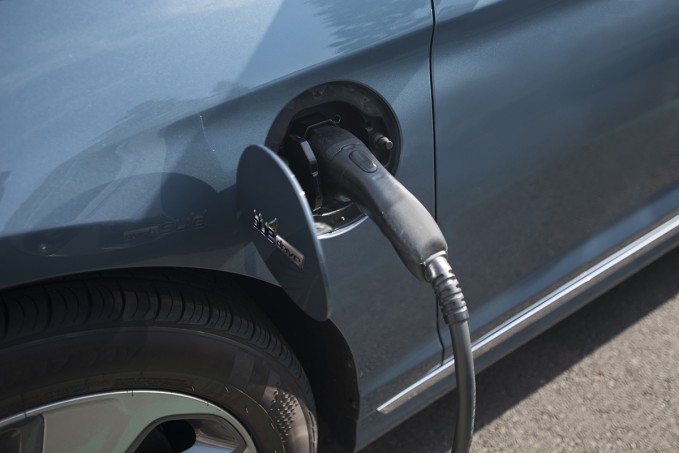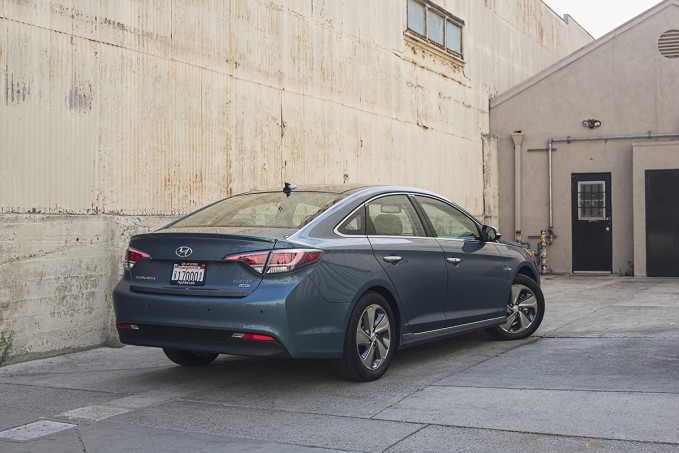The seventh-generation Hyundai Sonata is gaining two new variants for the 2016 model year: a hybrid to follow up on the sixth-generation’s hybrid model and a plug-in hybrid that offers even greater efficiency.
Stylistic changes for the hybrid siblings exist, but they’re subtle. The front and rear fascia get slightly different treatments and the rear quarter panels have blockier, backswept sides that trade aesthetics for aerodynamics if only by a little. Similarly, the hybrid models get wheels with broad spokes meant to reduce drag. In fact, Hyundai says the new model in hybrid form has the same drag coefficient as the Tesla Model S.
Generally, the hybrid and plug-in hybrid variants of the new Sonata look like their gasoline-only siblings. The sixth-generation Sonata made a splash by introducing Hyundai’s “fluidic” design language and the new Sonata wears the latest “Fluidic 2.0” design that will appear on all future Hyundai models.
What Else is New?
The biggest single change to the lineup for this year is the addition of a PHEV model. Hyundai uses a lithium ion polymer battery rather than the lithium ion packs in the Fusion hybrid and Accord hybrid or the nickel metal hydride technology Toyota still uses in the Camry Hybrid. This go-around, Hyundai’s battery pack is better at holding and dispensing energy.
Estimated gas mileage from the EPA isn’t available for the plug-in hybrid yet, but the regular hybrid is supposed to return 40 MPG around town, 44 MPG on the highway and a combined average of 42 MPG. Hyundai estimates that the plug-in hybrid model will offer an average of 40 MPG between city and highway driving. If that holds true, it will be enough to beat the Ford Fusion Energi, but behind the Honda Accord Plug-In Hybrid. Then again, the PHEV Accord is relatively scarce because of a limited supply, so this car might make for a reasonable compromise.
Compromising What?
For better or worse, hybrid and PHEVs are shackled with shortcomings. The hybrid equipment in their powertrains requires more packaging space than a traditional internal combustion design does. Generally speaking, trunk space is the first to go. Sometimes you also forgo a folding rear seat for the sake of 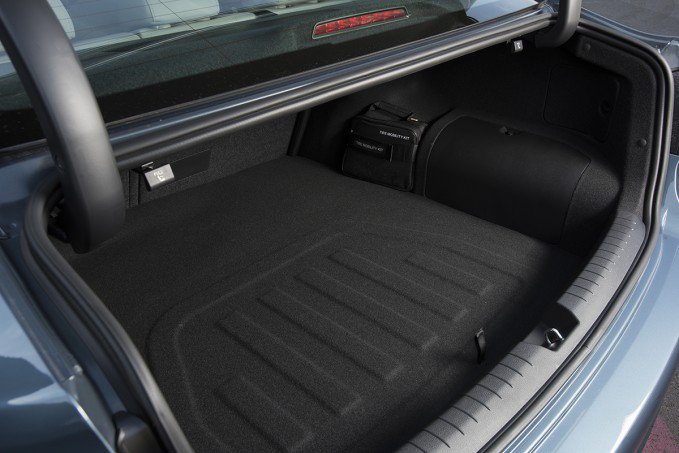
Upgrade your “green” status to the PHEV model and space shrinks further to 9.9 cubic feet. Then again, that’s actually more spacious than what you get with a comparable Accord or Fusion. Oh and that battery pack? Hyundai is backing it up with a lifetime warranty to quell concerns about long-term cost of ownership.
Legroom in the Sonata Hybrid is roughly on par with its competitors in the segment, which is important because the previous version was an inch stingier in that regard than the new model. Similarly, headroom is slightly more generous in the new generation and just shy of being segment leading when you take both front and back seat passengers into account.
Comfort-A-Plenty
Road noise is reasonably muted in the new Sonata Hybrid. Outside sounds aren’t deadened totally – for that you need to shell out Maybach money – but it’s all kept to a whisper. The front buckets and rear outboard seats are reasonably comfortable although we found in the past during a side-by-side comparison that the Honda Accord is more comfortable to drive. Despite that, there really isn’t anything to complain about in the Sonata. It’s easy to adjust the driver seat and steering wheel for a comfortable position. Like most modern sedans, it’s almost impossible to make effective use of the rear window to back the car up, but Hyundai’s rear-view camera does a fine job of showing a wide-angle view, so it’s still easy to drive in reverse when necessary.
Speaking of computer-aided driving technology, the new hybrid models come with a revised gauge cluster that includes a program to rate your driving. It scores your driving as economical, normal or aggressive. But rather than berating you for being a ham-fisted gas waster, the car can actually coach you to drive more efficiently by indicating when it’s appropriate to start coasting. You probably won’t see a huge mileage improvement by following the guide, but Hyundai says most drivers can expect a 3 percent bump.
Hyundai’s new BlueLink telematics system is also worth mentioning. The user interface is straightforward and aesthetically appealing. Better still, you can use a smartphone or even a smartwatch to remotely control things like climate control and your door locks.
Updated Powertrain
The new generation vehicle uses a 2.0-liter direct-injection four-cylinder engine that replaces the old 2.4-liter engine from the previous model. It makes 154 hp and 140 lb-ft of torque without electric help. With that at play, the system creates a total 193 HP in the normal hybrid and 202 HP in PHEV form.
As is the case in most modern cars, the Hyundai Sonata Hybrid offers a choice of drive modes that include eco, normal and sport settings. Although there is a noticeable difference in how the Sonata Hybrid behaves based on them, it never feels powerful. Throttle response is generally pretty sluggish, but then again that’s a typical trait for hybrids.
Be that as it may, there’s good news in how the latest Hyundai hybrid handles itself. The steering wheel’s on-center feeling is more pronounced than it was in the previous generation. That gives it a more natural feeling than the previous system, but it still isn’t predictably smooth in how it adds weight as the electrically boosted steering systems are in the best modern systems on sale today. Take a tip from me, don’t let that turn you off. Knifelike precision is important when you’re shopping for a performance car, but it really doesn’t matter with these things.
What does matter is that the plug-in model can travel at up to 75 MPH on electric power for a maximum distance of 24 miles. It can recharge completely in three hours on a level 2 charger. Oh, and just like the last Sonata Hybrid, the current car is only available with a six-speed automatic. The difference is that this time Hyundai tweaked the gearbox to make it more efficient by giving it a high voltage electric oil pump.
CVTs are improving rapidly, but for what it’s worth the six-speed manual is pleasantly smooth in how it changes gears and predictable in how it performs. As was the case before, the automatic uses a 38 kW electric motor in place of a torque converter. That’s a larger motor than the previous model and also the key factor in how Hyundai’s system is able to transition smoothly between gasoline and electric propulsion.
Packaging
Hyundai hasn’t announced pricing for the new Sonata Hybrid yet, so it’s impossible to form an opinion on how this car stacks up to its competitors from a value standpoint. Then again, this is Hyundai so you can bet it’s going to be competitive.
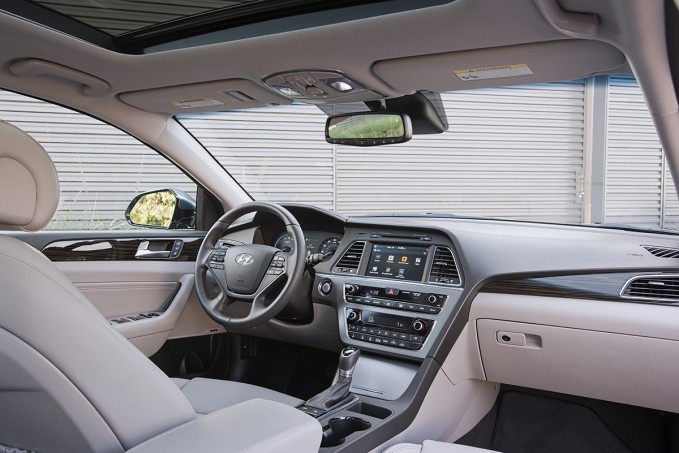
Limited models come with larger wheels, heated and cooled leather seats with power adjustment.
What’s nice about Hyundai’s approach to this business is that it still tries to attract customers based on value. Now I can only comment on that to a limited degree because Hyundai hasn’t released pricing for the hybrid or PHEV models yet, but these are some of the highlights from their standard equipment list.
You get 16-inch alloy wheels, LED daytime running lights and taillights, a 60/40 split rear bench, blind spot monitoring, an eight-inch touchscreen and manual sun shades for the second row to name a few. You also get access to the “Ultimate” package, which includes lane departure warning, forward collision warning, rear parking assistance, adaptive cruise control and more.
The Verdict: 2016 Hyundai Sonata Hybrid, PHEV Review
Assuming Hyundai prices the new Sonata Hybrid appropriately, the greenest version of the seventh-gen car is a fresh and particularly stylish alternative to owning a comparable midsizer from Ford, Honda or Toyota.







